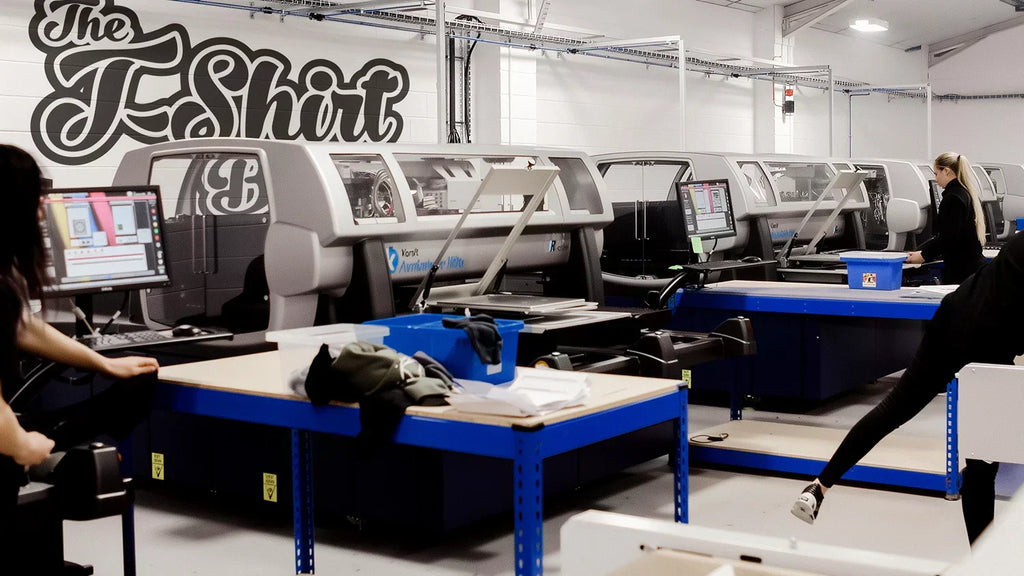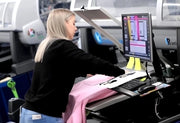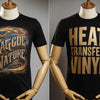🖨️ What Is DTG Printing? (2025 Edition)

🖨️ A Step-by-Step Guide to DTG Printing
If you’ve ever wanted to print a high-detail, full-colour image straight onto a T-shirt — no screens, no mess — DTG printing (direct-to-garment) is your answer. It’s ideal for startup brands, merch creators, and artists who want professional-quality prints without ordering in bulk. Unlike traditional screen printing, DTG uses advanced inkjet technology to print directly onto garments. It’s fast, eco-friendly, and perfect for one-off designs or limited runs of event merchandise.
And if you’re printing larger volumes? Our Kornit Atlas DTG printer delivers stunning detail at scale, making bulk DTG printing a viable option for growing clothing brands. This guide walks you through how DTG works, when to use it, and how to get the best results.
🧠 What Is DTG Printing and How Does It Work?
DTG stands for direct-to-garment. It’s a digital printing method that uses inkjet technology to spray water-based ink directly onto the fabric. Unlike screen printing, there’s no need to create stencils or layer up colour by colour. Instead, the printer applies your design in one smooth pass — with precision, speed, and impressive detail. On dark or non-white garments, a white under base is laid down first to make the colours stand out.
DTG printing offers unmatched flexibility for creators and businesses. Whether you're experimenting with a new design or preparing a branded merchandise launch, DTG provides a fast, scalable, and professional solution. It’s especially well-suited to intricate artwork or photo-style graphic tees.
- Ideal for both bulk printing and short runs, as well as one-off designs
- Supports full-colour, photo-realistic prints
- No setup fees or screens are required
- Eco-friendlier than traditional methods
DTG works best on organic cotton T-shirts, where the fibres absorb ink for a clean, vibrant result. If you're printing on dark shirts, a pre-treatment is applied before printing to help white and bright colours pop.
You’ll see DTG used across our Stanley/Stella collection for soft-touch premium blanks, kids custom sweatshirts for low-minimum orders, and event merchandise when high-quality prints are needed fast.
👉 Learn more about our DTG printing services.
🎨 What Designs Work Best with DTG?
DTG printing (Direct-to-Garment) is ideal for intricate, colourful designs that require fine detail and a soft-touch finish. Thanks to our Kornit Atlas and Avalanche HD6 printers, your artwork is applied with incredible precision using a CMYKRG+White setup — great for vibrant results without any setup fees.

Design types that suit DTG include:
- Promotional merch
- Portraits and character illustrations
- Detailed or textured logos
- Multicoloured artwork and full-colour photo prints
- Artistic graphics with soft shading
Modern DTG printers support both CMYK and RGB channels; however, when submitting artwork to The T-Shirt Bakery, we recommend saving your files in RGB mode for the most vibrant output. However, DTG isn't suitable for metallics, neons, or exact Pantone-matched colours. Designs with semi-transparent areas or very fine lines may also need adjustments. For best results, use our artwork setup guide or order a custom t-shirt as a test print before committing.
We recommend printing on 100% cotton — explore our organic t-shirt collection and affordable blanks to suit any style or budget.
✅ DTG Printing: Pros and Cons ❌
Direct to Garment (DTG) printing has quickly become one of the most flexible and sustainable options for customising clothing — especially for small runs or test batches. But, like all methods, it has its strengths and limitations. Here’s a quick breakdown of what DTG does well and where it might fall short.
Pros |
Cons |
|---|---|
| ✅ No minimum order quantity | ❌ Only Works best on 100% cotton |
| ✅ Soft-feel prints (ink absorbs into fabric) | ❌ Less durable on stretchy or synthetic fabrics |
| ✅ Works with on-demand workflows | |
| ✅ Fast turnaround with fewer production steps | |
| ✅ Water-based, low-waste inks |
If you're testing a new clothing line or personalising T-shirts for events, DTG gives you the ability to print high-quality designs without committing to large volumes. It's also an excellent choice for print-on-demand stores seeking speed and simplicity without compromising on colour detail or fabric feel.
🧵 Choosing the Best T-Shirts for DTG
When it comes to direct-to-garment printing, your design is only half the equation — the blank garment plays a massive role in the final result. Not every T-shirt is created equal, and DTG printing demands fabric that works with the ink, not against it. If you want sharp detail, intense colours, and long-lasting wear, choosing the right blank is essential.
The best results come from soft, high-quality cotton garments with a tight, smooth weave — this helps the ink absorb evenly and ensures sharper detail.
When choosing a blank for DTG, pay close attention to:
- Fibre Content: DTG works best on 100% cotton — especially ringspun or combed cotton, which has fewer stray fibres and a softer hand feel.
- GSM (Grams per Square Metre): Heavier GSM (160–220) offers a more stable surface and richer colour payoff, but lighter GSM (140–160) can feel softer and be more breathable for summer or casual wear.
- Weave Tightness: Look for garments with a fine, smooth finish that won’t bleed ink — avoid heavy textures or slub fabrics.
- Fit & Style: A medium fit is a standard choice, but relaxed and oversized fits are gaining popularity among streetwear brands and lifestyle labels.
Top Picks for DTG Printing:
- Stanley/Stella’s Creator 2.0 — premium GOTS-certified organic cotton with a smooth print surface, ideal for eco brands.
- AWDis AT002 — a midweight, cost-effective staple with consistent DTG results — great for creators and bulk t-shirt printing.
Browse our full organic t-shirt collection for sustainable DTG-ready blanks, or take a look at our custom clothing options if you’re building your own range.
🖼️ How to Prepare Artwork for DTG Success
Preparing your artwork properly is one of the most important steps in achieving professional DTG print results. Even with premium blanks and industry-leading printers, poor file setup can ruin an otherwise perfect design. That’s why it’s worth spending a little extra time getting this part right, especially if you’re running a business or planning to launch your own t-shirt printing shop brand.
- 300 DPI at print size
- RGB colour mode
- Transparent background (PNG or vector recommended)
- No unnecessary background shapes or anti-aliasing
This is especially important when working with white or light-coloured t-shirts. Transparency errors, jagged edges, or low resolution are some of the most common t-shirt design mistakes — but they’re easily avoided with a few best practices.
If you're unsure about how to format your design, check out our full artwork setup guide or read 👉 Mastering the Art of Image Resolution to learn how resolution, scaling, and DPI affect your final print.
🌱 Is DTG Eco-Friendly?
DTG printing is widely regarded as one of the more sustainable options in the garment printing world. It uses water-based, biodegradable inks that are free from harsh chemicals like PVC or phthalates, commonly found in plastisol inks used for screen printing. This makes DTG safer for both the environment and the people handling the garments.

Because it’s a digital print process, DTG doesn’t require screens or setup chemicals, significantly reducing water usage and chemical discharge. There’s no overproduction, no stockpiling of printed goods, and less textile waste, making it ideal for print-on-demand workflows and eco-conscious brands.
Pair DTG with organic T-shirts, and you’re well on your way to building a greener, more responsible clothing brand. We recommend exploring our organic clothing options to take your commitment to sustainability even further.
Want to see it in action? Our Kornit DTG printers are OEKO-TEX® certified and engineered for low-impact, closed-loop production, supporting your ethical goals without compromising on quality.
🤔 Final Thoughts
DTG is one of the easiest and most effective ways to bring your designs to life, especially if you're just starting out. Whether you’re launching a small label, printing for events, or producing custom merch, it offers unbeatable flexibility, soft-feel results, and full-colour accuracy — all without setup costs.
With the right blanks, correctly prepared artwork, and a reliable DTG print process, you can create standout pieces that reflect your style or brand. It’s also a great fit for sustainable brands, especially when combined with organic cotton T-shirts and low-waste, eco-certified DTG systems like ours.
Have questions? Contact our team or explore more helpful guides below.
🖨️ DTG Printing FAQs
Common Questions About Direct to Garment Printing, Answered Simply
🖨️ What Does DTG Stand For?
DTG stands for Direct to Garment. It’s a modern digital printing method where water-based ink is applied directly to the fabric using specialist inkjet printers. Unlike screen printing, DTG doesn’t need screens or stencils — your design is printed in one go, making it perfect for detailed and colourful artwork. Learn more in our T-shirt printing guide.
🎨 Can DTG Printing Handle Full-Colour Designs?
Yes — DTG is ideal for printing high-resolution images, complex logos, illustrations, and photo-style artwork. It uses CMYKRG+White ink systems to achieve vibrant results. This makes it a favourite choice for artists, designers, and anyone who wants their work to pop on a T-shirt. See our tips for eye-catching printing for more inspiration.
👕 What Fabric Works Best for DTG?
DTG works best on 100% cotton, especially ringspun or combed cotton with a smooth surface. These fabrics absorb ink well and produce sharp, long-lasting results. For organic options, we recommend checking out our organic cotton T-shirt collection. Learn how different blanks compare in our Gildan vs Uneek comparison.
⚙️ Are There Setup Costs?
Nope! One of the biggest advantages of DTG printing is that there are no setup fees, screens, or mess. Your digital file goes straight to print — saving you time and money. Learn how this compares to traditional processes in our printing techniques guide.
💧 Do DTG Prints Last After Washing?
Yes! When printed on quality garments, DTG prints are very durable. Wash inside out at 30°C, avoid direct ironing on the print, and you’ll enjoy vivid colour for many wears. This flexibility makes DTG a favourite for small businesses and merch projects. See how branded apparel impacts perception in our branded identity article.
🌱 Is DTG Printing Eco-Friendly?
It can be — especially when paired with sustainable garments. DTG printing uses water-based inks and doesn’t require excess chemicals, unlike screen printing. With no overproduction or wasted stock, it supports greener workflows and sustainable brands. Discover why this matters in our eco printing article.










